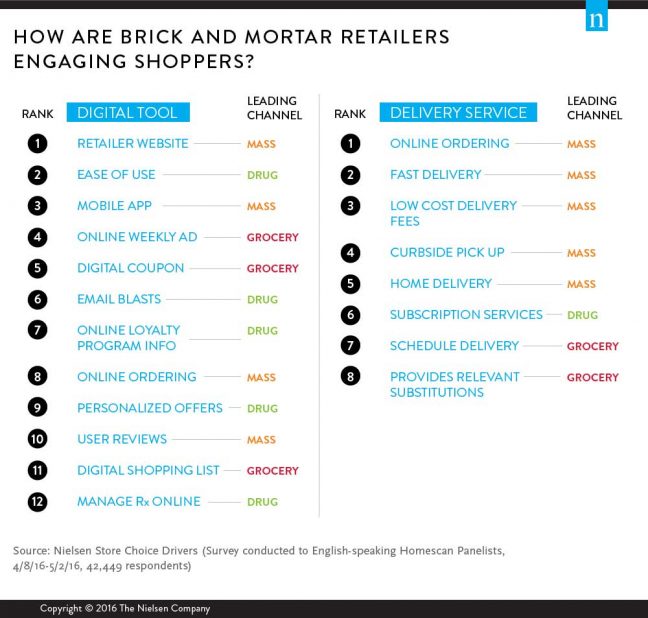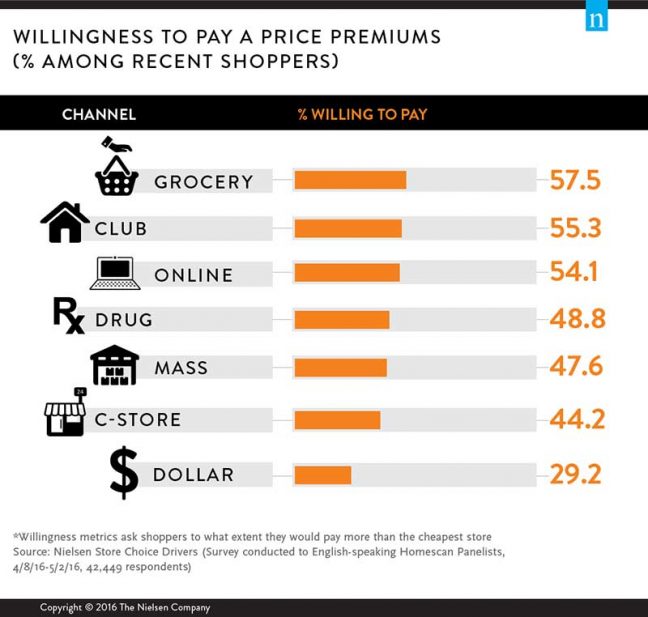Last updated on October 17th, 2016 at 10:35 am
In today’s retail environment where dollar sales growth has been small and unit sales growth flat, the main driver of retail channel and retailers’ sales levels has been changes in store count. While an uptick in penetration will always be an important part of any retailer’s strategy, it’s not the only tool in their tool belt. Keeping current shoppers happy and engaged boosts competitive advantage, increases average spend and protects the bottom line.
Yet, keeping shoppers satisfied has proven to be a formidable challenge for long-established retailers that have succumbed to a growing list of traditional, niche and digital competitors. There is an overwhelming abundance of choice for consumers across channels and formats. As choice runs rampant, retailers are constantly innovating new ways to engage consumers. But, how do they know which bets are the best bets?
Nielsen’s Store Choice Drivers study explores what drives relationships across retailers, channels and key shopper cohorts and how retailers are responding to changing perceptions and attitudes. When comparing what drivers are top of mind for U.S. shoppers vs. correlations made against retailer equity, a hierarchy of needs emerges. This ranges from the overstated importance of the basic needs for stores to fulfill to the latent, emerging needs that represent new frontiers that retailers will need to address.
While there are several basic and core needs that drive consumers’ choices, this year’s study identified several emerging opportunities retailers can tap into to help develop shopper loyalty. In fact, the study also confirms that some retailers have already had success across three of these trending areas.
 Health Positioning
Health Positioning
Health and wellness has increasingly become a mainstream trend with consumers, and they’re are increasingly embracing it as part of a sustainable future. As such, living a healthy lifestyle supported by natural/organic products continues to be important to the U.S. shopper. Retailers who leverage the trend by increasing such offerings on their shelves can differentiate themselves from their competition and develop loyalty.
The 2016 edition of Store Choice Drivers indicates that both the grocery and club channels already over-index for healthy lifestyle associations compared to all retail channels. Meanwhile, there is an opportunity for convenience stores to jump on the healthy lifestyle bandwagon.
The grocery channel also leads the way among all retail channels for natural/organic associations, with club following as a close second. Mass supercenters and c-store retailers have an opportunity to make inroads on this trend, potentially by increasing their fresh prepared food selections.
Emerging Tools
While still not ranked as the most important attribute in determining store equity, emerging tools—including digital engagement, delivery services, etc.—has been gaining steam since 2014 and are showing signs of future potential.
According to the Store Choice Drivers study, the grocery, mass and drug channels are all highly associated with digital tools, ranging across different media platforms and personalized services. However, grocery alone stands out for being associated with encouraging the use of digital shopping lists.
The mass and club channels are industry leaders for delivery services and online ordering. In particular, consumers give mass and club credit for offering fast delivery and low-cost delivery fees with online ordering.
Proximity and Premium
 When looking at the relationships shoppers have across retailers, the grocery channel remains the dominant player across all trip types. The convenience and ease of online retailing hasn’t replaced the need to touch and feel consumer goods that proximity retailing offers.
When looking at the relationships shoppers have across retailers, the grocery channel remains the dominant player across all trip types. The convenience and ease of online retailing hasn’t replaced the need to touch and feel consumer goods that proximity retailing offers.
At the same time, grocery and club command the highest spot when it comes to consumers’ “willingness to pay price premiums” and are widely leveraged for stock-up trips. Even though the economic recovery has been uneven, shoppers seem to have eased up on placing the same emphasis on value that was so commonplace after the Great Recession.
While emerging trends are important for retailers to identify their next steps, they also need to keep shoppers’ consistent core needs in mind. To improve overall equity among shoppers, retailers should consider the relevance of the following attributes in their respective channels: well-stocked assortment, quality fresh options, convenient one-stop shopping and social values (such as trust and health).
With a solidified approach that addresses these core needs, retailers can confidently delve into emerging opportunities to help differentiate and develop increased loyalty. Understanding where promoting healthy lifestyles and offering a varied assortment (including prepared foods, natural/organic products and store brands) and one-stop shopping, among other things, will help retailers keep in lock step with the ever-evolving consumer and a step ahead of the competition.






